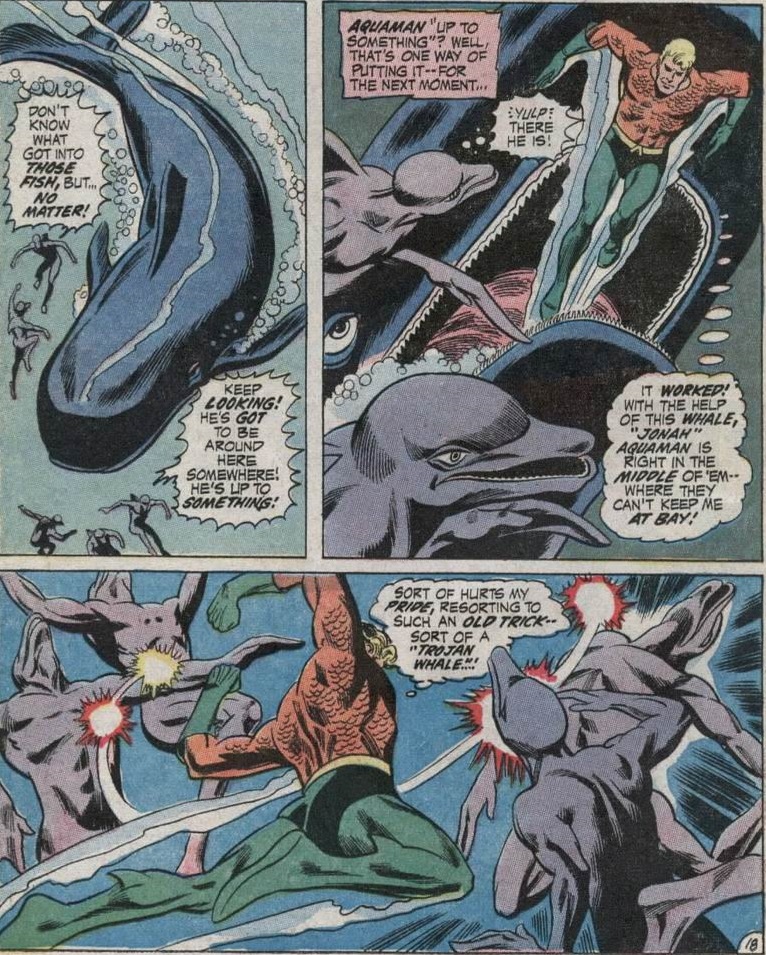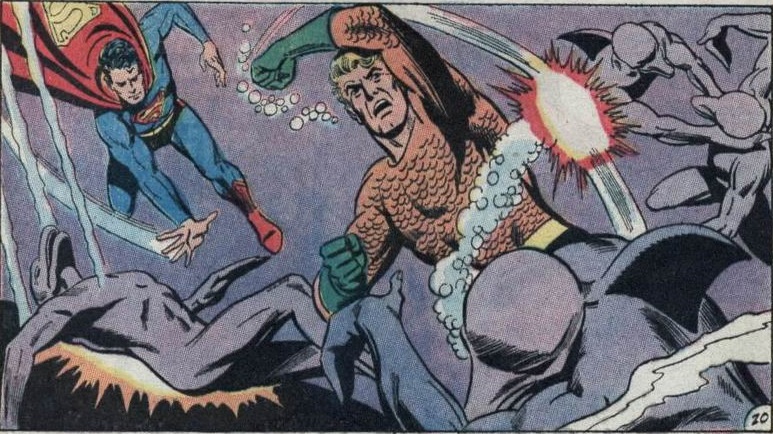
Hello fellow Internet wanderers, and welcome to another edition of Into the Bronze Age, finishing up our coverage of December 1971. I’m afraid that there is a cloud hanging over our celebration of the joy of classic comics today, as a tragedy has struck the FF community. We recently learned of the death of Cyber Burn, content creator extraordinaire, my constant aide and ally, my dear friend, and all-around great human being. He was an amazing guy, and we are all grieving his loss. I’m going to write more about him and his importance to our community and literally everything I ever created for FF in a future post. At the moment, I don’t have the capacity to do him justice, though I am far from certain that I ever will be up to that particular herculean task.
In the meantime, let’s celebrate one of the things that always brought him joy, one of the things that, for him, as for many of us, served as a refuge from the ugliness and tawdriness of the world around us, the realm of the fantastic, the brighter, more hopeful terrain, of superhero comics. Let’s see what our last books of the month have in store for us.
If you’re new to this little journey, you can check out the first post to learn what it’s all about.
Roll Call
(You can see everything published this month HERE)
Action Comics #407Adventure Comics #413Batman #237Detective Comics #418The Flash #211Green Lantern/Green Arrow #87Justice League of America #95Mr. Miracle #5Phantom Strange #16Superboy #180Superman #246 (#245 was all reprints)Superman’s Girlfriend, Lois Lane #117- Superman’s Pal, Jimmy Olsen #144
- Teen Titans #36
- World’s Finest #208
Bolded entries are covered in this post, the others will be covered soon.
Superman’s Pal, Jimmy Olsen #144
“A Big Thing in a Deep Scottish Lake!”
Writer/Penciler: Jack Kirby
Inkers: Vince Colletta and Murphy Anderson
Letterer: John Costanza
Editors: Jack Kirby and E. Nelson Bridwell
DNA Project: “The Torn Photograph”
Writer/Penciler: Jack Kirby
Inker: Vince Colletta
Letterer John Costanza
Editors: Jack Kirby and E. Nelson Bridwell
Newsboy Legion: “Kings for a Day!”
Writers: Joe Simon and Jack Kirby
Penciler: Jack Kirby
Inker: Joe Simon
Letterer: Howard Ferguson
Editors: Whitney Ellsworth
The first book in this batch is that misfit, redheaded step-child of the Fourth World titles, Jimmy Olsen, but unlike the bizarre, confusing mixture of ideas from the previous pair of issues, this month the King gives us something much more focused and fun. As you might guess from the cover, this comic sees the Newsboy Legion and our titular cub reporter coming face to snout with an ersatz Loch Ness Monster. In such an aquatic adventure there’s even a chance that Flippa Dippa might actually be useful….but I wouldn’t count on it. The cover image itself is a pretty good one, with a nicely dynamic and exciting central drama unfolding upon it, as the Legion hang on for dear life or leap to safety during their impromptu shipwreck. The whole thing has the King’s trademark energy and excitement. Superman doesn’t quite fit in with the picture, both because of Murphy Anderson’s overwriting of Kirby’s work and because he’s not really part of the dominant scene. That is actually rather accurate, as he plays no role in Jimmy’s plot, but it looks a bit odd to have him disproportionately soaring past as his young friends face pseudo-Nessie’s watery wrath, ‘Sorry kids, I’ve got super-business back in Metropolis, good luck with the monster!’
Kirby’s cover is a pretty fair promise of what awaits us within, and our tale begins with a Kirby-tech speedboat racing across the surface of “Loch Trevor,” which is totally not Loch Ness, thankyouverymuch. The pilot of the craft is searching for a supposed sea monster that stalks the waters of the Loch, and he finds it, or rather, it finds him, in rather dramatic fashion, destroying his ship and setting the stage for our adventure. Back in Metropolis, everyone’s favorite corporate shark, Morgan Edge, is raking Jimmy Olsen and the Newsboy Legion over the coals for failing to come back with a story. Of course, they have a heck of a story about “The Project,” but they’ve been sworn to secrecy. The King also seems to have forgotten that he last left Jimmy Olsen watching musicals projected onto the clouds of a miniature Universal Monster-themed world, so one would imagine he’s got quite the story to tell himself! Nonetheless, the heinous head of Galaxy Broadcasting casually dismisses the Legion’s claim that their Whiz Wagon was destroyed by a bomb and sends them out to chase down the scoop on the sea monster of Loch Trevor. Man, the gang are awfully forgiving about all of Edge’s attempts to kill them. You think they’d be a tad more insistent about that whole thing. Yet, once they’re out of his office, he opens the secret screen in his desk that we saw in this month’s Lois Lane, but this time he’s not looking at himself. Instead, he orders a hit on the Newsboy Legion!

Meanwhile, all crime everywhere has apparently been stopped, because Superman and the Guardian are spending their time dropping by a “discotheque,” not for charity, not as a benefit, not working a case, but just to “help their attendance.” Oookay? I’m glad they’ve got their priorities straight. Inside, they meet the young woman who is running the place, a girl named Terry Dean, who we saw briefly in #138. It seems she first appeared in a rather interesting sounding issue, #127, wherein Jimmy Olsen goes undercover to expose a slumlord. It’s neat and a little surprising that Kirby is making use of this minor supporting character introduced before his run, though I wouldn’t have minded some editorial reminders here. At any rate, Dean introduces them to a super Kirby-ified band, the San Diego Five String Mob, who are secretly serving Apokolips. They are wonderfully cool looking, in that inimical Kirby style of gonzo gadgets and weird wardrobes. As the malevolent musicians maintain their cover, playing strange music, Dubbilex, the D.N.Alien suddenly appears, bringing with him a warning!
The King cuts away before we see what comes of that, though, and we travel to the skies over Scotland, where Jimmy and the Legion are literally dumped out of a fancy jet in the Whiz Wagon. Scrapper is determined he’s going to fit in, and has dressed the part, complete with kilt and Tam o’ Shanter, but unfortunately, his voice gives him away every time he opens his mouth, which becomes a running gag. On the ground, the gang nearly run over their contact, Felix MacFinney, as they try to stop their careening car, but they manage to do no permanent harm. This whole scene is fun and Kirby actually gives us some fairly charming humor, though we’re also besieged with comically exaggerated Scottish accents at every turn.
Back in the “discotheque,” Dubbilex reveals to the Man of Steel that there is a tunnel under the club that leads right back to the Project, but it is a tunnel the good guys didn’t make! Well, the bad band certainly can recognize a cue, so they prepare to strike…giving us a weird and interesting little sequence. They each play a note, summoning their “Sixth String,” Barri-boy, who is just another guy with a crazy instrument, but he literally brings the house down when he plays! That seems a little inefficient, but it’s still a fun sequence.
Back in Scotland, our neophyte newshawks meet MacFinney’s lovely daughter and engage in some banter while the plan for the monster-hunt the next day. MacFinney also shows them a device he created to attract the marine menace. Nothing suspicious here, nope! The next morning finds them out on the Loch, monitoring Flippa Dippa as he swims in its murky depths. Suddenly, he’s ambushed below the waves by a fellow frogman, and the others prepare to go to his aid, only to find themselves looking down the barrel of MacFinney’s gun! It seems that the Scotsman is actually an Intergang assassin! Fortunately, while Jimmy distracts the gunsel, the little Scrapper Trooper that the full-sized Scrapper brought along slips away and activates the monster lure. The situation is resolved in dramatic fashion, as the creature swamps the boat and seizes MacFinney, leaving the others soaked but safe. When they reach the shore, they find Flippa Dippa there ahead of them, having overcome his assailant, MacFinney’s “daughter,” another Intergang assassin. One wonders, how inept must she be at her job to have been taken out by Flippa Dippa? Confused but very curious, the gang determine to stay in Scotland and solve this monstrous mystery!
This is a fairly fun story, as silly as it is in parts, and the main plot, with Jimmy and the Newsboy Legion investigating the mystery and generally carrying on with their own banter and shenanigans, seems like a good fit for the characters. It’s a premise that serves them well, and I’d be happy to see the book settle onto a course like this. Heaven knows the last few issues have shown it is desperately in need of some direction. In terms of the writing, Kirby’s dialog, rather stilted and awkward in some of his other books, is generally in much better shape in this issue, provided you don’t mind his atrocious Scottish accents. He seems to have a good grasp of the voices of the Newsboys, which isn’t too surprising, seeing as they are his creations, after all. In fact, the interplay between Scrapper and the Scotsman, as well as the banter between the rest of the boys, is often genuinely funny and enjoyable. And then there’s everything Flippa Dippa says…the book’s resident embarrassment has fairly cringe-inducing lines throughout, like: “This ghetto guppie says ‘yeah!'” and “My SCUBA cells are vibratin’, Jimmy.” It is rather funny in an almost meta sense how desperately enthusiastic he is when he discovers that their adventure will involve a body of water, like he realizes how completely pointless he is as a character. Overall, Flippa Dippa aside, this is an enjoyable adventure. The King’s unmatched creativity is once again on display, but all of these different elements fit together much better than the bizarre horror-planet of the previous issues. Superman and the Guardian just sort of casually dropping by the club is pretty goofy, but the Kirby-tech band is so cool that I’m willing to give it a pass. Of course, the King’s art is great throughout, despite Colletta’s inking. I’ll give this promising start to a new adventure 4 Minutemen, with its sillier elements holding it back from a higher score.
P.S.: I’ve been really enjoying the Newsboy Legion stories that have been reprinted as backups in these books. They’re simple but fun.
Teen Titans #36
“The Tomb be Their Destiny”
Writer: Bob Haney
Penciler: George Tuska
Inker: Nick Cardy
Letterer: John Costanza
Editor: Murray Boltinoff
Aqualad: “The Girl of the Shadows”
Writer: Steve Skeates
Penciler/Inker: Jim Aparo
Letterer: Jim Aparo
“Superboy Meets Robin the Boy Wonder”
Writer: Bill Finger
Penciler: Al Plastino
Inker: Al Plastino
Editor: Jack Schiff
“The Teenager from Nowhere”
Writer: Bob Haney
Penciler/Inker: Nick Cardy
Letterer: Ben Oda
Editor: Mort Weisinger
Well, if this month’s Jimmy Olsen issue was an improvement over the previous one, we can’t really say the same for this month’s Teen Titans, which is rather disappointing. The book continues to limp along without a clear direction and without any real reason for the Titans to actually be involved in its plots. To start with, we’ve got an okay cover, with a hint of mystery to it, though the perspective and layout is a bit wonky. I’m not really sure how those stairs exist in relation to the angle of the floor at the front. While the scene is non-Euclidean, it is also atmospheric, but the context is a bit too vague for it to be entirely successful. Our heroes seem to be hunting this figure rather than trying to rescue him, but he’s turning to dust, which his dialog tells us is….bad, as if they’re out to help him? It’s just not terribly successful.
Unfortunately, the story itself isn’t much better. It picks up where we left off in our last issue, in the purported crypt of the “real” Romeo and Juliet, where Robin, Speedy, Wonder Girl, and the superfluous Mr. Jupiter examine the scene and debate whether Lilith is really the incarnation of Romeo’s star-crossed lady love. They spot a shadowy figure and give chase, only to be temporarily trapped by a cave-in. While they are delayed, the shadowy figure sneaks off with the unconscious forms of Romeo and Lilith (doesn’t have quite the same ring as the original, does it?).
The misshapen figure turns out to be a hunchbacked madman named “Calibano,” who is supposed to resemble Romeo’s cousin of the same name, though I wouldn’t have gotten that from the art alone. As the young lovers revive, this Calibano tells them that Romeo and Juliet were actually part of a love triangle, with him as the third angle. Lilith uses her power of vagueness to learn that it was actually him who killed the original moon-struck Montague, causing Juliet to take her own life. Then, he apparently got trapped in their tomb and put into suspended animation…by…plot? Seriously, that’s not explained at all.

Now Calibano’s convinced that the new couple are the originals reawakened, as he was, and he challenges Romeo 2.0 to a duel, and the brave young man fights a desperate battle while Lilith makes the valuable contribution of…shouting…and…looking worried. It’s just a very impressive showing for a superheroine. As the ancient feud reunites, the rest of the Titans follow the trail of their lost teammate, only to come across the other Calibano leading a water-borne funeral procession. We’re reminded that the police were interested in the Loggia family, and this funereal flotilla out on a foggy night seems suspicious.
Suddenly, Mr. Juptier, who let’s remember has displayed no particular skills or abilities or received any special training up to this point, decides that he’s an action hero, and he and Robin investigate the suspect ships. The pair discover that the casket is a cover for smuggling industrial diamonds (which really doesn’t seem all that worthwhile, really), and overcome a bunch of frogmen in an extended scene where neither of them is apparently troubled by the need to, you know, breath for what one can only assume is a good 15-20 minutes. The marine marvel millionaire hauls himself out of the water to confront Calibano, and is nearly killed, only to have his life saved by the sudden arrival of Don Loggia, who is actually honest, though still a jerk, and who was suspicious of his nephew.
While Robin was being upstaged by a random dude with no qualifications for hero work, the other two Titans arrive just in time to save Romeo…by straight-up murdering the original Calibano! That’s right, Speedy shoots the guy with a sharp arrow as opposed to any of the zillion trick arrows he carries. He shoots him right in the chest, and though the poor fellow is able to stagger back to the crypt, he definitely dies. (Man, the books this month have had an unusually high body count for the era!) The story ends with the characters wondering if Lilith and Romeo are actually the reincarnations of their much more interesting and famous predecessors, and we are told that they are totally in love. Yep, definitely deeply and really in love, a love that is absolutely going to last beyond this issue and will certainly carry significance for years to come. Or not. Yeah, it will probably not surprise y’all to learn that our dear friend, Zany Haney, the anti-continuity cop, completely drops that particular plot thread, and this Romeo guy is never heard from again. It’s just as well, because the whole ‘reincarnated Romeo and Juliet’ angle doesn’t seem super sustainable over the long-haul.
So, what are we to make of this story? Well, much like the previous issue, it’s not an entirely bad tale, by itself, but it isn’t particularly suitable for the Teen Titans, and there is absolutely no reason for these characters to be here. The actual Titans contribute almost nothing to the story, short of Speedy murdering a poor, deformed, and mentally ill fellow. That’s the part of the story that galls me most, as Haney gives Speedy exactly one panel to feel a little bad about missing the sword and shooting the guy straight in the chest, and that is it, as if this wasn’t entirely avoidable if the character was acting in any normal fashion. And, of course, because it’s a Zany Haney plot, this killing will never be mentioned or thought-of again, and that’s terrible on multiple levels.
Let’s also not forget Haney just casually adding a character and a whole subplot to what is arguably the most famous play of all time. It’s not quite as bonkers as it seems, though, as it is very likely that “Calibano” and his plotline were drawn from “Caliban,” a character in another of Shakespeare’s plays, The Tempest. In that story of magic and mysticism, Caliban was the misshapen and monstrous servant of the wizard Prospero and was also the unlucky angle of a love triangle. Nonetheless, even if Calibano has respectable origins in another of the Bard’s tales, his presence in this story is weird and a bit disconcerting, especially because the last issue ended with the young couple discovering the apparently mummified remains of Calibano, who was also wearing different clothes. Continuity errors aside, this whole thing is just a bit of a mess. Everything happens at the speed of plot, and the two plotlines end up feeling entirely alien to each other, despite the attempts to connect them with the multiple Calibanos. You could pretty much drop the entire Loggia family plot thread from this issue and lose nothing except for Mr. Jupiter’s inexplicable display of commando skills.
As you might be able to tell, I have just about lost all patience with this whole premise. This whole ‘superhero summer camp’ thing we’ve got going on, with the Titans involved in this vague project with Jupiter, just has nothing to recommend it to me. Lilith also continues to be vague and pointless, only now she is joined in her uselessness by Wonder Girl, who does nothing all issue. I find myself wishing we could see the Titans be, you know, superheroes. On the plus side, the team of Tuska and Cardy continues to be great, really turning out some lovely work with lots of darkly atmospheric scenes that add some drama and mystery to this silly plot. Their work is really deserving of a better story. So, what is the final score? Well, I would probably have given this one 2.5 Minutemen like its first half if it weren’t for Haney having Speedy kill the antagonist with zero justification, logic, or examination. That plus ‘secret agent-Jupiter’ sours the story for me, so I’ll give it 1 Minuteman. Haney is really batting 1000 this month.
“The Girl of the Shadows”
Interestingly, this issue has another little Aqualad backup, which is cool, but it is a super brief one, only running 3 pages. Apparently, this little mini-adventure, by the wonderful SAG team, was actually slated to appear in the cancelled Aquaman #57, and it was put into inventory when that book never materialized. Unfortunately, that also meant that this intriguing little tale and the mysteries that it introduces are never resolved! What a crying shame! Being only 3 pages, there’s really not enough here to judge, so I’ll just share all three pages and offer a brief overview.
It begins with the young Aquatic Ace emerging onto darkened docks, searching for a girl that had intrigued him when he saw her earlier at a concert (don’t tell Tula!). Just as he finds her and she gives him a cryptic greeting, she is confronted by a big man in strange armor who tries to capture the mysterious maiden. The Sea Prince cleans his clock, then asks the girl for an explanation. All she says is that they must “get past the wall — before it’s too late!”, and then she disappears, leaving our young hero to wonder what this strange encounter was all about. So, we are left with a mystery that will likely never be solved, and that’s a shame, because Skeates set the stage for an interesting story, and I would have quite enjoyed it if he had been given a chance to finish it in these pages.
“The Teen-Ager from Nowhere”
This month’s Titans issue actually held two original backups, and the second is a solo Lilith story, which is actually a good deal better than you’d probably expect from what we’ve seen of her in the main book. This little tale is something of an origin story, and in just 7 pages Haney gives us more information about Lilith and more reason to care about her than in all of the issues she’s been in up to this point combined. It is still, of course, pretty vague, but that vagueness is at least a bit more understandable here, and the story also seems to promise some answers might be forthcoming.
It begins when a 12 year old Lilith sees a group of men leaving her small Kentucky town to search for the body of a young boy presumed drowned in the river. Suddenly she runs after them and yells that he’s not in the river, leading them into the hills and finally to an old well. They find and rescue the boy, but then they begin to wonder how she knew he was there. The young girl can’t explain her knowledge, and the crowd grows more suspicious until her father finally arrives and takes her home. Back in the safety of her own house, her parents are supportive, but the pre-teen psychic senses that she is actually adopted, and she runs out of the house in search of her origins.

In fact, she runs all the way to the orphanage that once sheltered her, where somehow the matron recognizes and remembers her, despite the fact that she was only one year old when she was adopted. Neat trick! Lilith learns that her powers were apparently shared by her real mother, who brought her to the orphanage after some mysterious trouble relating to her father. The kindly matron warns the strange girl not to dredge up the tragedies of the past, but the youth swears that she will discover who she is, though she is glad when her adoptive parents come to fetch her home.
This is a surprisingly good story for focusing on Lilith, and it shows that she could be a decent character if she was given any development or personality other than “mysteriousness.” The girl’s lack of understanding of her powers or past is much more believable and excusable, as she is just beginning her journey. A 12-year-old not being able to explain a first flash of psychic insight is much more understandable and palatable than, say, a college-age girl doing the same after having lived with such abilities for years. Nick Cardy’s art is just plain gorgeous, as always, and he brings so much humanity and emotion to his characters that you can’t help but sympathize with the lost young girl or her concerned parents. Haney’s writing is positively restrained and thoughtful here, and the final result is a really solid and intriguing backup that actually makes me, of all things, look forward to more stories about Lilith! I’ll give it 4 Minutemen, as it isn’t quite strong enough to reach a higher score, .
World’s Finest #208
Cover Artists: Neal Adams and Gaspar Saladino
“Peril of the Planet-Smashers!”
Writer: Len Wein
Penciler: Dick Dillin
Inker: Joe Giella
Letterer: John Costanza
Editors: Julius Schwartz and E. Nelson Bridwell
“The Inside Story of Robotman!”
Writer: Joseph Samachson
Penciler/Inker: Jimmy Thompson
Editor: Jack Schiff
Ghost Patrol: “The ‘Spectacular’ Crimes”
Writer: John Broome
Penciler: Carmine Infantino
Inker: Frank Giacoia
Editor: Sheldon Mayer
Oh man, what an awesome cover! How could you pass by the newsstand and not plunk down your quarter to see what kind of story could have such an epic image over its pages? Many of us have probably heard the old saying that the Silver Age Superman could “juggle planets,” but that expression, which captures the casual omnipotence of the character and thus one of the flaws with his portrayal in the era, doesn’t really apply here. Instead, we get a wonderful portrayal of a truly epic feat that feels properly epic. You can see the strain and effort on Superman’s face, like a moment out of the wonderful old Fleischer Superman cartoons, where the Man of Steel would constantly be pushed to his limits to defeat his foes and rescue his friends. It feels heroic and exciting in the extreme, and it is beautifully and powerfully rendered by Neal Adams. In fact, it’s such a cool cover, that I’ve been anxiously anticipating its approach in my lineup, quietly excited to read the story it represents. So, does the tale within live up to that dynamite image? Perhaps a better question is, could anything?
Sadly, although Wein and Dillin give us a good super-story inside, it isn’t quite the amazing epic that our cover promises us. It begins with Dr. Fate helping the police to recover a stolen “thermal-ray,” which is apparently insanely dangerous for a hand weapon, but the technological marvel and its erstwhile criminal owners are a poor match for the master of magic, who simply causes the device’s trigger to disappear! That’s a wonderfully clever and straightforward solution to the threat. However, his heroics are soon interrupted by an emergency call from…the hospital?? Apparently this Dr. Fate is a literal medical doctor, which was completely news to me. I always knew him as an archaeologist, but apparently, his earliest appearances had him sharing his fellow Justice Society member, Dr. Mid-Nite’s profession. Who knew? Surprisingly, what awaits the good doctor at the hospital is not your average case but an ailing alien! The strange-looking being telepathically communicates the mental message that “Earth is doomed!” The medical magician is left stunned, realizing that he must save this creature’s life, or its secret will die with it, and so may the Earth itself!
Meanwhile, our other heroic headliner is hanging out on a satellite above Earth 1, contemplating his magical misadventure from the previous issue. We find Superman lamenting the fact that he has two whole weaknesses in his otherwise invulnerable form. Boo-freaking-hoo, the poor sun-god is only mostly invulnerable! Just then, the morose Man of Steel hits upon the idea of seeking succor from one of his mystical allies and heads out to consult the Mistress of Magic, Zatanna. On the way, he casually disposes of a radioactive dust cloud by sucking it into his lungs and then blowing it into the sun. Yep, clearly he’s not powerful enough! Unfortunately, Zatanna tells the Action Ace that she can’t help him, because her father told her that “to know how our powers work would cause them to stop working!” Now, I don’t know, but I’m pretty sure that just means that Zatarra didn’t feel like answering a young Zatanna’s questions…I do enjoy Zatanna just casually doing crazy magic as she talks to Supes, almost like she’s rubbing it in.
Having exhausted his options on Earth 1, Kal conceives of an alternative, and he goes to visit his other spell-slinging friend, Dr. Fate, on Earth 2. The Man of Tomorrow arrives just in time to help his fellow hero with his unusual patient, and mage teleports them to his tower and fills his guest in on the plot. Apparently this alien was just hanging out in the sky over a city and was struck by a plane (imagine being the pilot and trying to report that!). I suppose you’ve got to be prepared for things like this when you live in the DC Universe. The Arcane Avenger supernaturally scans his patient’s mind and discovers images of two landmarks, a Mayan temple and Stone Henge, and the heroes split up to investigate the mysterious threat facing the world.
Dr. Fate travels to the Mayan temple, only to discover another alien just “sitting” in the sky, meditating, and ignoring him. When the occult hero presses his case, the strange being casually causes the surrounding flora to grow and attack, and the wizardly warrior has to employ his magical might to escape from the plant-based peril, literally blowing up some one of the hungrier heinous herbs from the inside! It’s a nice little sequence, and Dillin renders it well. However, just when Fate is ready to grab his alien attacker, the being simply vanishes!
On the other side of the world, Superman doesn’t have much better luck in England, where the same pattern repeats itself, though with a giant formed from the ground itself in place of the sinister shrubbery that attacked his ally. The sand is too soft for the Man of Might’s blows to have much of an impact, so he tries a different tack, turning the entire colossus into glass with his heat vision, and shattering it with a powerful blow, another really cool sequence, with an honestly clever resolution. Yet, just as with Fate, the mysterious meditator vanishes when approached. What could these baffling beings be up to? Well, as the heroes prepare to regroup, they each encounter strangely sudden natural disasters, with Dr. Fate stopping a rampaging tidal wave and Superman saving a city from an unexpected volcanic eruption.
Comparing notes, the dauntless duo discover that the continents of Earth 2 are being drawn together, and the planet is heading towards an apocalyptic ending! Risking another probe of their injured alien, they discover that he was a member of the Buudak, the “high lamas” of an ancient race, who are seeking an interplanetary Nirvana, one that can only be found through the release of energies resulting from the destruction of the Earth! The heroes confront the alien trio as they prepare their final psychic attack, but both might and magic prove futile. In desperation, the dauntless dyad decide to combine their abilities, and Dr. Fate channels his preternatural power into the Metropolis Marvel, giving him mystical might to match his star-born strength.
The supercharged Superman is able to shrug off the alien’s attacks, smashing their psychic shield, and the terrible trio vanish as their own powers consume them. However, despite their defeat, the world is not yet saved, and the continents continue to converge! The master of magic reclaims his power and forges occult chains, and Superman hauls the rogue land masses back into place! The adventure ends with the world restored and with the Man of Might having decided that his vulnerability is for the best after all because…and see if you can follow this, he was only able to save the day because Fate’s magic could effect him…though one wonders just how often such a situation is going to arise. To be fair, the Kryptonian’s actual last thought makes more sense, as he notes that “a little humility is good even for a Superman.” That is almost certainly true, and in fact, I might say “especially good”.

Muddled moral aside, this was a pretty fun issue. Dr. Fate and Superman make for an unusual team, and it is interesting to see them in action together. They are in many ways opposites in terms of their powersets, with one being a physical juggernaut, while the other is a magical powerhouse. It’s a pairing that we don’t see too often, and I enjoyed the casual yet logical reason behind their team-up. Superman just happens to show up looking for answers, and he drops into an adventure already in progress. Good enough, and it makes the world of DC feel a bit more interconnected. The incredibly powerful alien lamas made for solid antagonists, though I would have liked to know a bit more about them. Their objective, spiritual enlightenment at all costs, is also an unusual one, adding an interesting twist on the standard ‘destroy the world’ plot, but their casual dismissal of the lives they’re about to destroy does raise some questions about their ethos! Our heroes’ efforts make for an entertaining and exciting tale, especially in the first half. Unfortunately, the final confrontation and climax aren’t as successful. Dillin makes the first challenges the team faces visually interesting and fun, especially Superman’s fight with the sand giant, but the last attack isn’t nearly as engaging, though it is serviceable enough. The real problem with this story, and it is a minor one, is that Dillin’s portrayal of that wonderfully dramatic moment from the cover just simply pales in comparison. It’s fairly uninspiring rather than the show-stopping scene it really should be. Still, if the worst you can say about a comic is that it has one moment that isn’t as impressive as its cover, then you’re not doing too badly! In the end, this is a really enjoyable adventure, if not quite as epic and memorable as the cover promised. I’ll give it a strong 4 Minutemen.
Final thoughts
Well, with these three books, we have reached the end of December 1971, and an interesting end it is! This month saw quite a collection of comics, with few high highs but several quite low lows. Nonetheless, we had an unusual number of moderately high scoring books this month, with a lot of them earning 4 Minutemen, even if few scored higher. Overall, it was a fairly enjoyable month of comics, with several pleasant surprises along the way, including Action Comics, Adventure‘s new Zatanna backup, The Creeper’s guest spot, Superman‘s plankton-fueled panic, and more. There were a few real clunkers, though, with the master of madcap plots, Zaney Haney, turning in two terrible tales that even his insane energy can’t save. We’re seeing some books dragging, like Teen Titans, while others, like Jimmy Olsen have hopefully begun to recover, though Kirby’s 4th World work is so wild and uneven, there’s no promise of that. One thing is certain, both Zaney Haney and the King will have something unique and creative for us next month, whether it sinks or swims.
In terms of themes, this has been a fascinating month, with many a book aiming at a significance that its story can’t quite match. Nonetheless, there are some really interesting attempts to tackle heavier ideas in this batch of books, and the social relevance revolution is on full display. We’ve got obvious examples, like Green Lantern / Green Arrow, which attempted to address racism in O’Neil’s usual rather ham-handed fashion, but which did succeed in achieving some real importance by introducing John Stewart, a new black hero who would go on to become an excellent and worthwhile addition to the DC Universe. If his portrayal in this first appearance was rather one-note, his very existence was still rather remarkable. The Green Arrow backup also aimed at relevance, and with a fair amount of success too. That unusual ground that tale trod had to feel particularly revolutionary in 1971, with Ollie questioning how much good a superhero could actually do in light of the social problems plaguing the country. O’Neil’s attempts at verisimilitude and relevance are effective, if rather depressing.
Though the issues that percolate in the background of the story are vague and unexplored, the sense of unrest and tension fits with what we’ve been seeing in many of the other other books that have tried to take on such themes. In fact, we find that this idea has plenty of company this month. Interestingly, we see just that same vague sense of tension, especially among the youth, reflected in Justice League, where we meet an ersatz Jimi Hendrix. Of course, the most fascinating element in that story was its look at the plight of Vietnam veterans, though sadly it was given little more than a glimpse. This issue does recognize the power that music was playing in the counter-cultural movement, a concept which we also see show up in much more fantastic and strange fashion in Superman’s visit to the “discotheque.” Unfortunately, Jimi Hendrix never quite managed managed to rock hard enough to bring down a literal roof.
Nonetheless, we can see how much DC comics have changed in just a year, with so many different teams on so many different titles attempting to engage the tumultuous culture of their day to a degree that was much more rare when we started our journey. One of the most unexpected of these attempts was our backup Kid Flash tale, which featured another wealthy businessman as an antagonist, which is becoming a much more common trope, but which also focused, not on environmentalism as has already become common, but instead on nutrition. That really surprised me, showing up in 1971, as I think of that as a much more modern concern. Heck, I grew up in the 80s, where preservatives and all manner of additives in our super-processed food was just the norm! It’s the carcinogens that make it tasty!
Social relevance wasn’t the only connection to the real world that we saw in our books this month. We also got to see the first appearance of the Rutland Halloween Parade in DC Comics, which was quite entertaining, though that issue did have some problems with tone, combining the light-hearted fun with the heavy drama of holocaust survivors and escaped Nazi war criminals…real laugh-a-minute stuff! Despite its rather schizophrenic tone, it did manage to be an interesting and memorable issue. After all, it’s not every day you see Batman sharing the page with Thor and Spider-Man!
All-in-all, there were a lot of really entertaining reads this month, and we saw a lot of great art in the pages of our various books, even when the stories themselves weren’t quite as good. Pleasantly, even when the main tales tank, I find myself really enjoying several of our backups, like The World of Krypton, Rose and Thorn, and especially the new Zatanna feature. I’m really looking forward to seeing what comes out of that one. Despite its unevenness, I’m still excited about reading the rest of the 4th World as it develops. Though there are several runs that I find myself wishing would end, there is still plenty to be excited about. I wonder what next month will bring us!
Well, there’s only one way to find out! I hope that y’all will join me again soon(ish) for another edition of Into the Bronze Age! I’ll be posting a tribute to our fallen friend, Cyber Burn first, and I hope that y’all will join me for that as well and honor his memory. Until next time, keep the Heroic Ideal alive!

























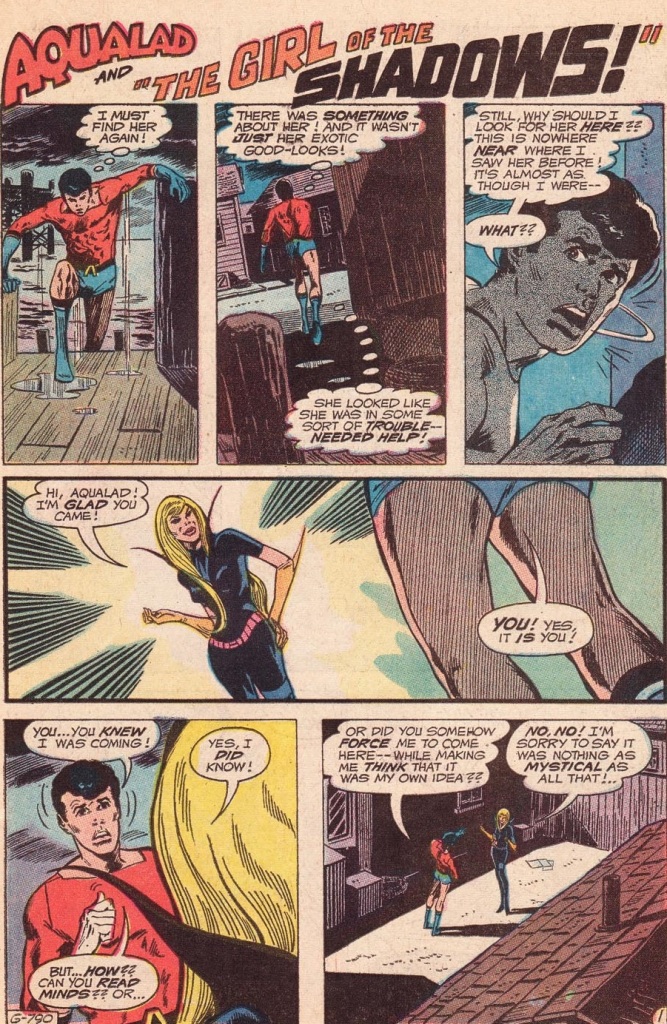








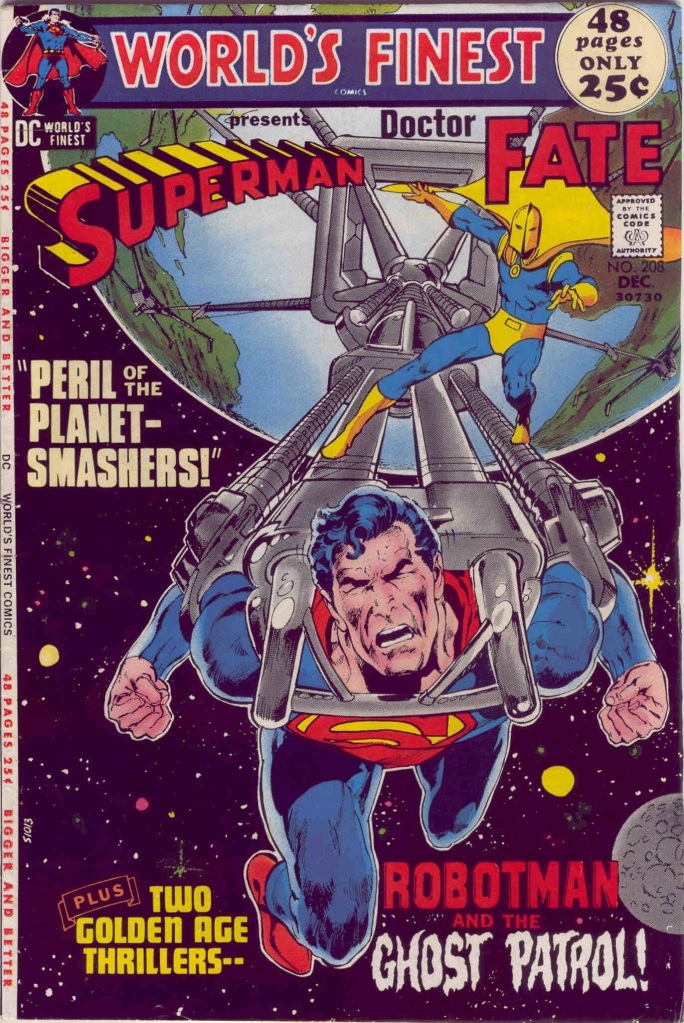







































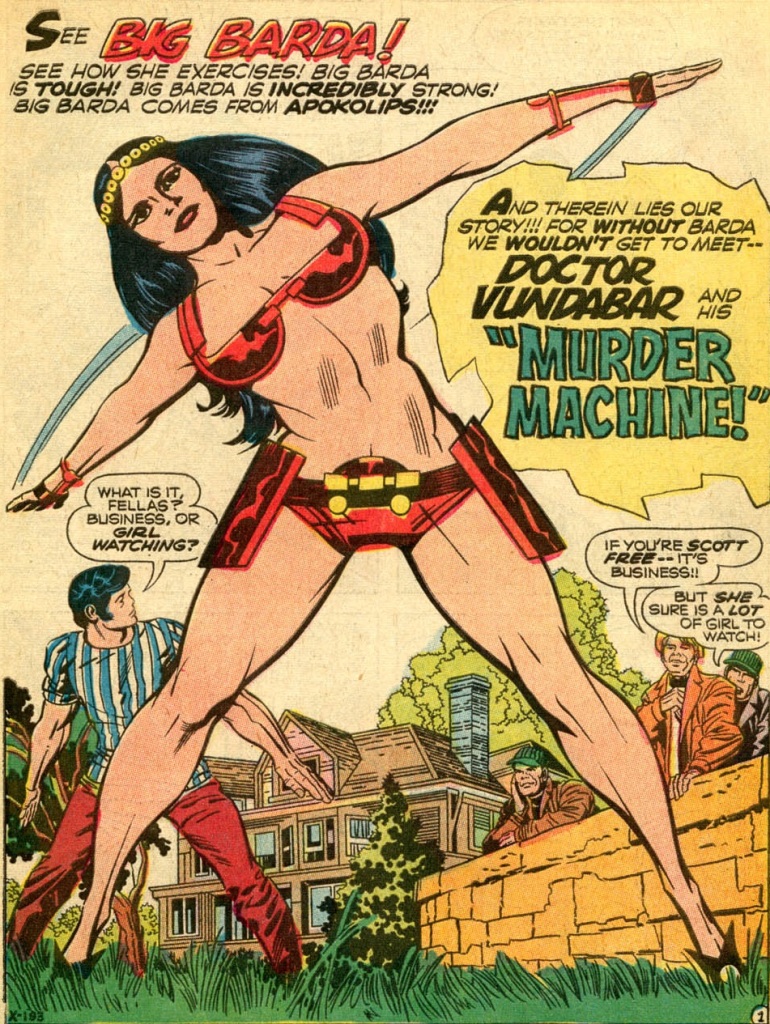







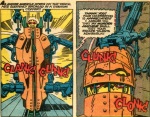























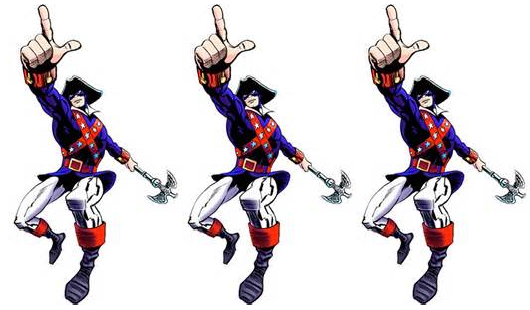




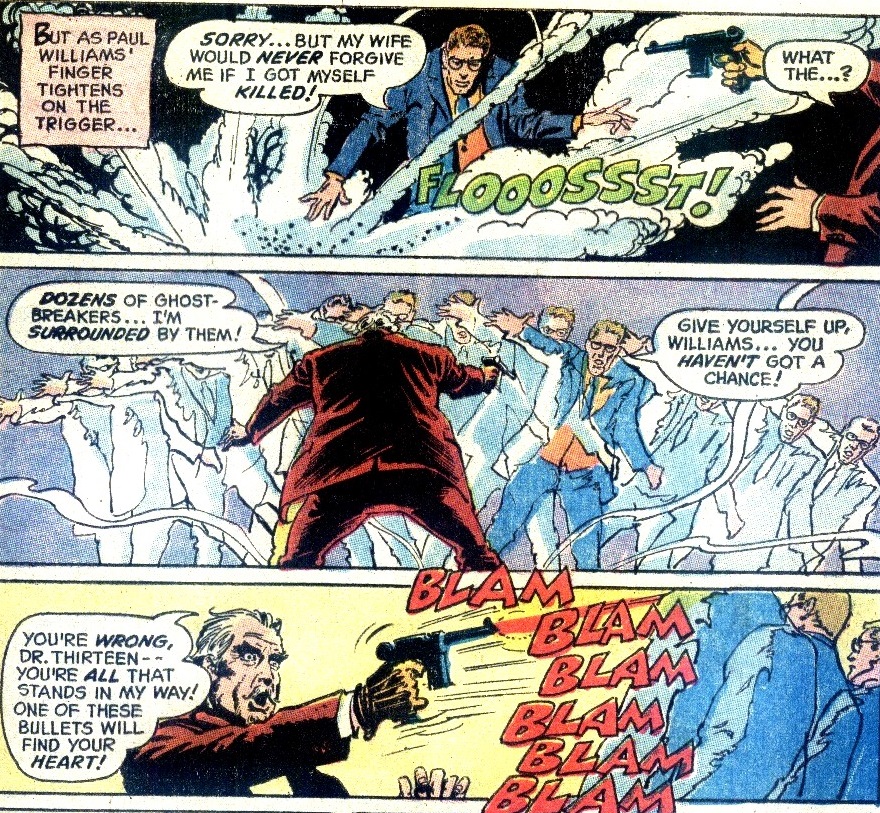

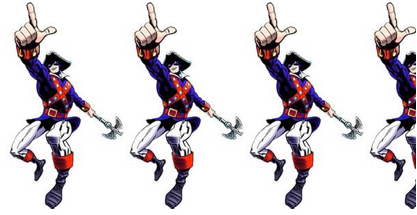
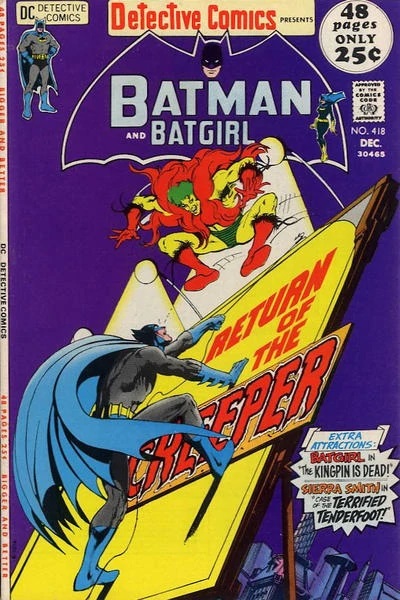























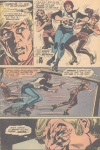






















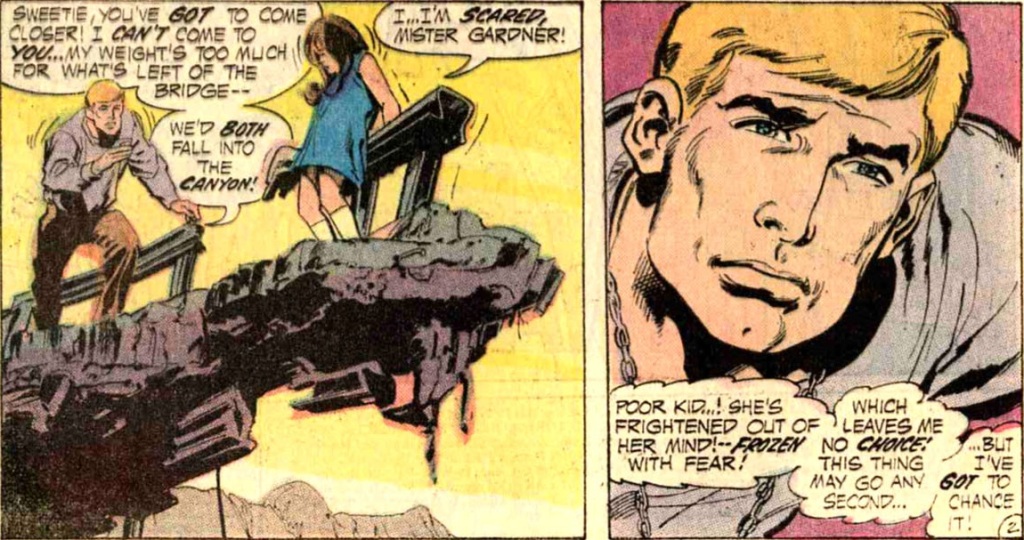













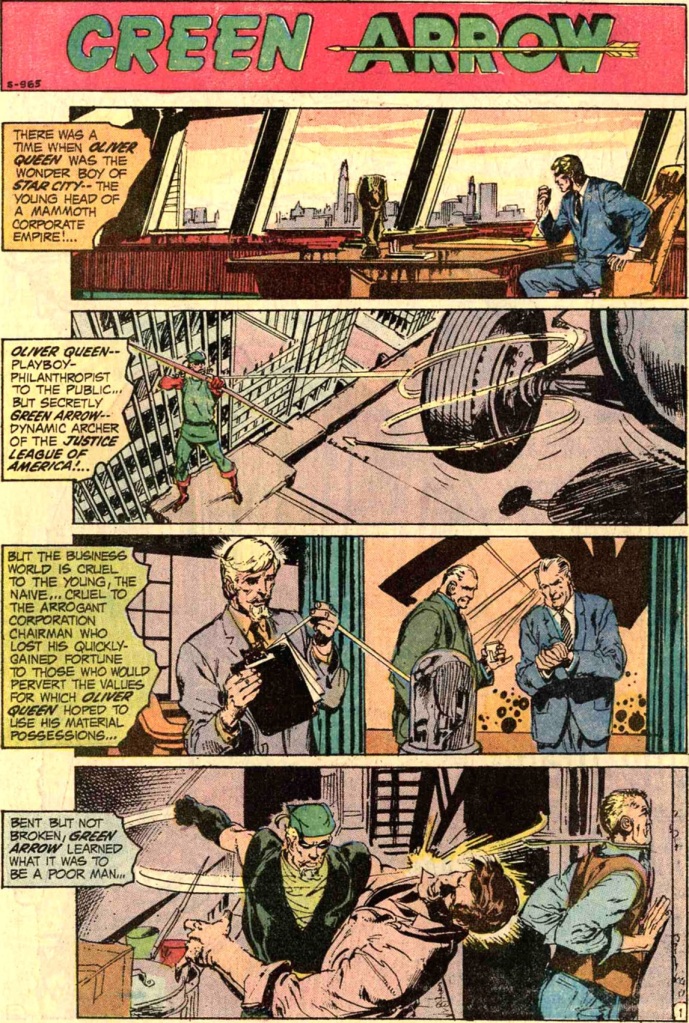

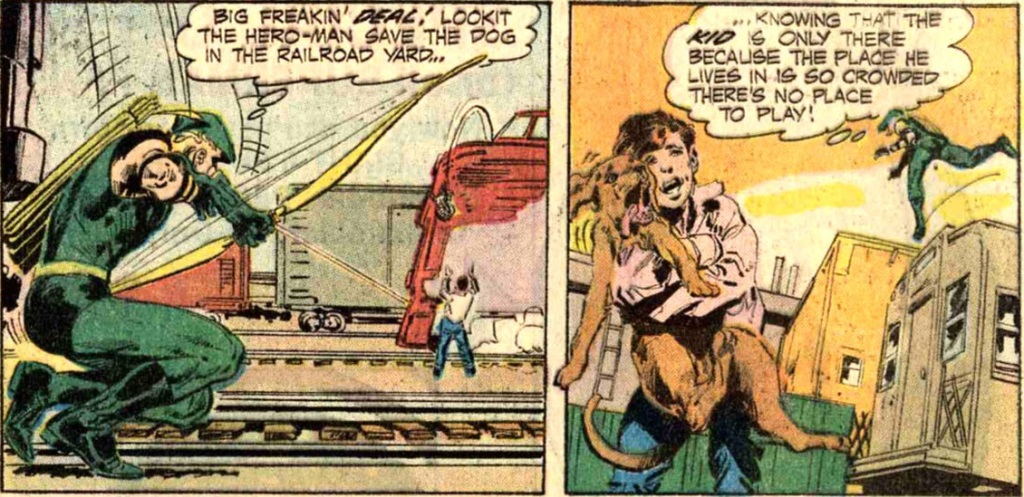







































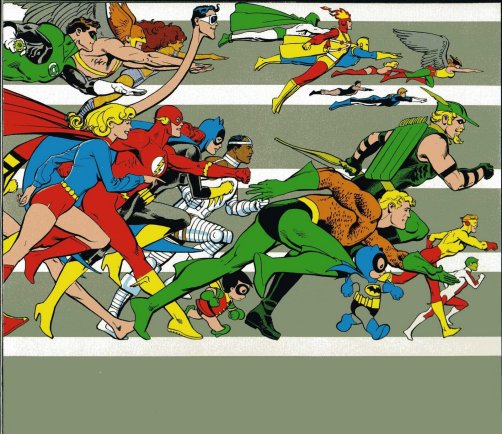

























































 Despite the ugly cover, the first images that greet a reader inside are really quite impressive. Kirby is experimenting with his photo-collages again, trying to create an otherworldly effect for Clark Kent’s journey into the strange alternate dimension in the booby-trapped capsule from the last issue. The result is pretty striking and successfully cosmic. After floating helplessly for a time, the mild mannered one is visited by Lightray, who eventually rescues him. Yet, Clark doesn’t escape before he gets a brief glimpse of New Genesis and Apokolips in their great cosmic dance. This brief interaction is really cool and, sadly, way more interesting than what takes the bulk of the comic’s focus.
Despite the ugly cover, the first images that greet a reader inside are really quite impressive. Kirby is experimenting with his photo-collages again, trying to create an otherworldly effect for Clark Kent’s journey into the strange alternate dimension in the booby-trapped capsule from the last issue. The result is pretty striking and successfully cosmic. After floating helplessly for a time, the mild mannered one is visited by Lightray, who eventually rescues him. Yet, Clark doesn’t escape before he gets a brief glimpse of New Genesis and Apokolips in their great cosmic dance. This brief interaction is really cool and, sadly, way more interesting than what takes the bulk of the comic’s focus.

 While the reporter roves around in the Fourth World, his three friends, Jimmy Olsen, the Guardian, and…urg…”Goody” Rickles, find themselves deposited on the side of the road by Intergang, poisoned and facing a fiery fate. The cloned hero sends the other two to seek help at the nearest hospital….ohh, wait, no. That might make sense. He sends them to the Daily Planet instead. The Guardian himself sets off after the villain’s rolling headquarters to capture an antidote, and Kirby treats us to a few panels of his revived Golden Age hero leaping rooftop to rooftop in classic fashion.
While the reporter roves around in the Fourth World, his three friends, Jimmy Olsen, the Guardian, and…urg…”Goody” Rickles, find themselves deposited on the side of the road by Intergang, poisoned and facing a fiery fate. The cloned hero sends the other two to seek help at the nearest hospital….ohh, wait, no. That might make sense. He sends them to the Daily Planet instead. The Guardian himself sets off after the villain’s rolling headquarters to capture an antidote, and Kirby treats us to a few panels of his revived Golden Age hero leaping rooftop to rooftop in classic fashion.












 This is not the only sign that something is not right. A scene change find Wonder Girl and Lilith acting like stereotypical 50s TV girls, sitting around, pining over boys and exercising no agency in their lives. Yet, when Clark Kent shows up on TV to read the news, Lilith’s subconscious reaches out to him, and Mr. Mild Mannered has a vision of an old man discovering a strange machine in a cave and transmits the message “THE TEEN TITANS ARE TRAPPED IN FAIRFIELD!” Startled, Clark actually says that on the air, which leads to confusion from the girls and anger from everyone’s favorite corporate shark, Morgan Edge.
This is not the only sign that something is not right. A scene change find Wonder Girl and Lilith acting like stereotypical 50s TV girls, sitting around, pining over boys and exercising no agency in their lives. Yet, when Clark Kent shows up on TV to read the news, Lilith’s subconscious reaches out to him, and Mr. Mild Mannered has a vision of an old man discovering a strange machine in a cave and transmits the message “THE TEEN TITANS ARE TRAPPED IN FAIRFIELD!” Startled, Clark actually says that on the air, which leads to confusion from the girls and anger from everyone’s favorite corporate shark, Morgan Edge.





























 In the speed dimension, the Sentinel tells Flash that the strange place is being attacked by a being he calls the Devourer, which is trying to tear its way into the hero’s universe. The being takes a number of random forms, shifting rapidly, including a giant rat, ram, blowtorch, and T-Rex. All of the Scarlet Speedster’s attacks are ineffective, but he finally reasons that, since the normal physical laws don’t apply in this bizarre place, he should try something completely random that would be ineffective in his home dimension.
In the speed dimension, the Sentinel tells Flash that the strange place is being attacked by a being he calls the Devourer, which is trying to tear its way into the hero’s universe. The being takes a number of random forms, shifting rapidly, including a giant rat, ram, blowtorch, and T-Rex. All of the Scarlet Speedster’s attacks are ineffective, but he finally reasons that, since the normal physical laws don’t apply in this bizarre place, he should try something completely random that would be ineffective in his home dimension.



 In a fun bit of detail, he notes that when he started out he expected to be stumbling over heists all the time, but unlike in “comic mags,” such things have proven rare. Yet, when he goes to eject his costume from his ring, a strange gas emerges instead, knocking him out!
In a fun bit of detail, he notes that when he started out he expected to be stumbling over heists all the time, but unlike in “comic mags,” such things have proven rare. Yet, when he goes to eject his costume from his ring, a strange gas emerges instead, knocking him out!












 Then Kirby’s inimitable imagination is on strange and unsettling display as he takes us on a tour of the torments Desaad has devised for our young heroes. First, Mark Moonrider is locked in another glass prison, this one rendering him as an animated skeleton to the people passing below. Big Bear, for his part, is in a shooting gallery where the park-goers see him as a robotic bear, and their each shot creates a cacophony of sonic chaos within his cell. Beautiful Dreamer has a more sedate torture in store for her, as the uber-creepy master masochist paralyzes her and inserts her into a glass coffin, where the illusion works in the opposite way of the others, rendering the harmless civilians who regard her as hideous monsters waiting to devour the helpless damsel.
Then Kirby’s inimitable imagination is on strange and unsettling display as he takes us on a tour of the torments Desaad has devised for our young heroes. First, Mark Moonrider is locked in another glass prison, this one rendering him as an animated skeleton to the people passing below. Big Bear, for his part, is in a shooting gallery where the park-goers see him as a robotic bear, and their each shot creates a cacophony of sonic chaos within his cell. Beautiful Dreamer has a more sedate torture in store for her, as the uber-creepy master masochist paralyzes her and inserts her into a glass coffin, where the illusion works in the opposite way of the others, rendering the harmless civilians who regard her as hideous monsters waiting to devour the helpless damsel.

































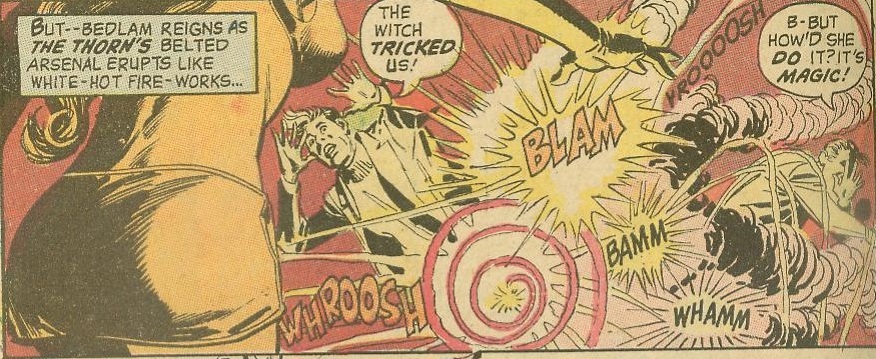





















 Smarting from their defeat, the punks decide that they must have revenge, and one of them draws a gun. Unaware they’re being chased, the couple stop by a radio studio, which is supposed to be the first part of their date (which seems like a weird choice), but when they open the elevator doors, they find, not the office they expected, but a bleak, blasted landscape! Suddenly, the not so wondrous woman is unable to breathe, and the Man of Steel realizes that there is very little oxygen in the atmosphere. At super speed, he finds a pocket of air underground and carries his date to safety. Building her a shelter, the Kryptonain, who doesn’t need air, sets out to see what is going on here.
Smarting from their defeat, the punks decide that they must have revenge, and one of them draws a gun. Unaware they’re being chased, the couple stop by a radio studio, which is supposed to be the first part of their date (which seems like a weird choice), but when they open the elevator doors, they find, not the office they expected, but a bleak, blasted landscape! Suddenly, the not so wondrous woman is unable to breathe, and the Man of Steel realizes that there is very little oxygen in the atmosphere. At super speed, he finds a pocket of air underground and carries his date to safety. Building her a shelter, the Kryptonain, who doesn’t need air, sets out to see what is going on here.


 Finding a bizarre, golden tower, the only sign of life on this desolate world, he charges in, smashing past defenses, only to find himself face to circuit with a robot, built into the structure itself. The machine explains that this is the future of the Earth, 2171, one hundred years in his future. Apparently, an event in Superman’s time lead to the destruction he has observed in this future. Notably, the android explains that this is just a possible future, and one which might be prevented if the catalyst event is altered. Realizing this, the mechanical man developed time travel capacity (how convenient!), allowing it to bring forward agents that could affect such change. To that end, it was the machine that manipulated events in the past to bring the two heroes together, which just seems unnecessarily complicated. It then shows Superman a clip of the defining moment, a college protest which turns into a riot, during which someone will be killed, someone who, otherwise, would prevent this future.
Finding a bizarre, golden tower, the only sign of life on this desolate world, he charges in, smashing past defenses, only to find himself face to circuit with a robot, built into the structure itself. The machine explains that this is the future of the Earth, 2171, one hundred years in his future. Apparently, an event in Superman’s time lead to the destruction he has observed in this future. Notably, the android explains that this is just a possible future, and one which might be prevented if the catalyst event is altered. Realizing this, the mechanical man developed time travel capacity (how convenient!), allowing it to bring forward agents that could affect such change. To that end, it was the machine that manipulated events in the past to bring the two heroes together, which just seems unnecessarily complicated. It then shows Superman a clip of the defining moment, a college protest which turns into a riot, during which someone will be killed, someone who, otherwise, would prevent this future.



 After rescuing the former Wonder Woman, the Man of Tomorrow heads back to the robot’s citadel, only to find it running out of energy. Gathering the other three unwilling time travelers, Superman desperately races to get back through the time rift before it closes, just barely making it. Grabbing Diana, he races off once again to reach the site of the destined riot, and the two split up to try and calm things down. Their efforts are for naught, though, as one of the hot-headed students throws a Molotov cocktail, blowing up a car, and the guards open fire. In the aftermath, Diana finds a kid safe and sound who matches the description of the future-bot, only for Superman to discover a dead guard who also could be the one. Desperately, the heroine asks her partner which one is their target, only for him to respond hopelessly that they’ll never know until it’s too late!
After rescuing the former Wonder Woman, the Man of Tomorrow heads back to the robot’s citadel, only to find it running out of energy. Gathering the other three unwilling time travelers, Superman desperately races to get back through the time rift before it closes, just barely making it. Grabbing Diana, he races off once again to reach the site of the destined riot, and the two split up to try and calm things down. Their efforts are for naught, though, as one of the hot-headed students throws a Molotov cocktail, blowing up a car, and the guards open fire. In the aftermath, Diana finds a kid safe and sound who matches the description of the future-bot, only for Superman to discover a dead guard who also could be the one. Desperately, the heroine asks her partner which one is their target, only for him to respond hopelessly that they’ll never know until it’s too late!



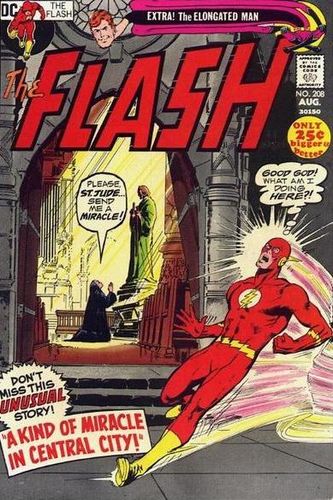











 Sure enough, the hunch pays off, and the hare is there. When the bold bunny sees the superhero arrive, he calls out to another costumed character, who tosses down a smoke bomb. Together the two steal the valuable tome while Ralph and the townsfolk take an impromptu nap. Upon awakening, the Ductile Detective deduces where the thieves will be hiding, from a scrap of paper he snatched from the rabbit. The notes reads “Mushroom Float,” and the hero realizes that the crooks plan to make their escape in plain sight, by hiding out among the costumed cast of the town’s anniversary parade!
Sure enough, the hunch pays off, and the hare is there. When the bold bunny sees the superhero arrive, he calls out to another costumed character, who tosses down a smoke bomb. Together the two steal the valuable tome while Ralph and the townsfolk take an impromptu nap. Upon awakening, the Ductile Detective deduces where the thieves will be hiding, from a scrap of paper he snatched from the rabbit. The notes reads “Mushroom Float,” and the hero realizes that the crooks plan to make their escape in plain sight, by hiding out among the costumed cast of the town’s anniversary parade!







 The heroes begin their investigation in the basement of Ollie’s own building, where he’d seen the kids who jumped him before. Downstairs they find one of the punks begging a charming fellow named Browden for a fix. It seems that Browden is a pusher! He turns away the junkie with a savage kick, and the partners decide to ask the jerk some questions. The guy proves suicidally brave, taking on two Justice Leaguers with a fire axe, but surprisingly this doesn’t prove to be the best idea. After capturing both the drug dealer and his client, the heroes plan to interrogate their prisoners.
The heroes begin their investigation in the basement of Ollie’s own building, where he’d seen the kids who jumped him before. Downstairs they find one of the punks begging a charming fellow named Browden for a fix. It seems that Browden is a pusher! He turns away the junkie with a savage kick, and the partners decide to ask the jerk some questions. The guy proves suicidally brave, taking on two Justice Leaguers with a fire axe, but surprisingly this doesn’t prove to be the best idea. After capturing both the drug dealer and his client, the heroes plan to interrogate their prisoners.


 Their group-therapy session is interrupted by the arrival of the Green Team, who fly in and capture the fleeing kids, only to be surprised to see that one of them is…Speedy?! Ollie instantly assumes that his ward is there undercover, and when one of the junkies helpfully offers to take the heroes to their suppliers, Arrow tells his young friend to stay behind while they wrap things up. On the way, the heroes talk with the kids, and in a notable inversion, it is the Emerald Archer who is the inflexible, judgemental one, while Hal takes a more thoughtful, moderate approach. It seems that Ollie has no patience for the kind of weakness that leads to drug use.
Their group-therapy session is interrupted by the arrival of the Green Team, who fly in and capture the fleeing kids, only to be surprised to see that one of them is…Speedy?! Ollie instantly assumes that his ward is there undercover, and when one of the junkies helpfully offers to take the heroes to their suppliers, Arrow tells his young friend to stay behind while they wrap things up. On the way, the heroes talk with the kids, and in a notable inversion, it is the Emerald Archer who is the inflexible, judgemental one, while Hal takes a more thoughtful, moderate approach. It seems that Ollie has no patience for the kind of weakness that leads to drug use.



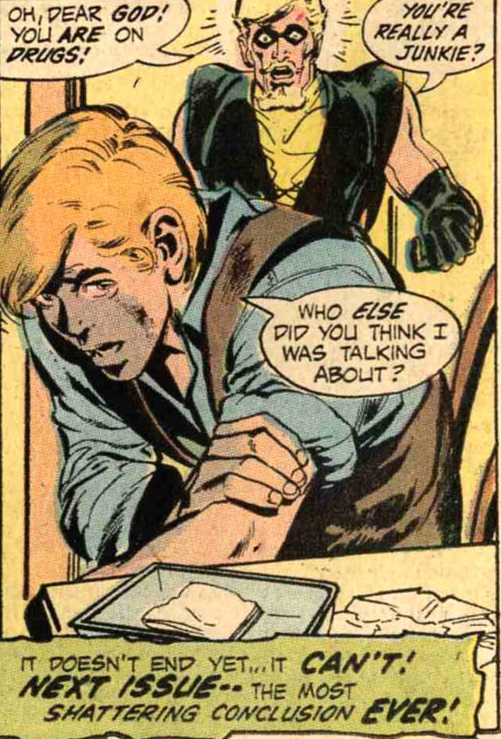 The reveal is, of course, not that surprising after the cover, but the twist of an honest-to-goodness superhero, not just a supporting character, becoming a drug-addict, must have been earth-shattering to fans in ’71, especially at DC. We’re still not very far removed from the era where DC heroes were spotless, flawless paragons of all virtues, and this is a huge departure from the line’s conventions. You simply didn’t see things like this in comics, especially DC Comics. This makes the issue itself an important milestone, in many ways representing the high-water mark of social relevance for the era.
The reveal is, of course, not that surprising after the cover, but the twist of an honest-to-goodness superhero, not just a supporting character, becoming a drug-addict, must have been earth-shattering to fans in ’71, especially at DC. We’re still not very far removed from the era where DC heroes were spotless, flawless paragons of all virtues, and this is a huge departure from the line’s conventions. You simply didn’t see things like this in comics, especially DC Comics. This makes the issue itself an important milestone, in many ways representing the high-water mark of social relevance for the era.



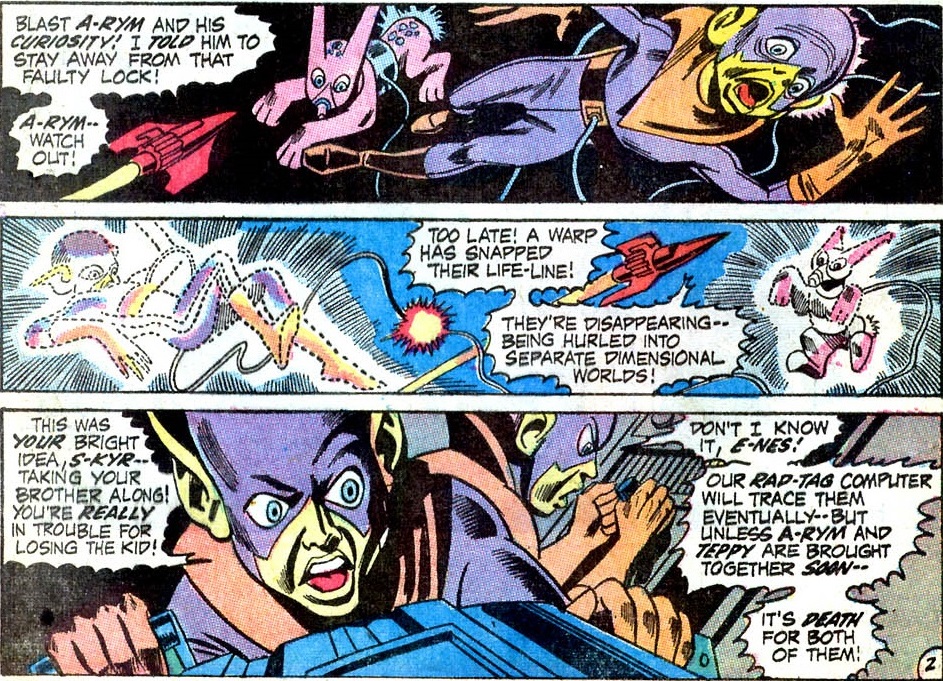
 On Earth 2, the Justice Society gathers, including their Superman, Hawkman, Flash, and Atom, as well as their Robin. They get a distress signal from their Green Lantern, and when they arrive, they find him battered and bruised from a bout with the alien boy. Apparently the yellow youth sensed that the Emerald Gladiator’s ring had the power to bridge dimensions, so he attacked the hero and stole the ring. The team sends their fallen friend back to base while they set out in search of the kid. Oddly, on the way, Hawkman talks down to Robin, telling him he “may as well fill in for Batman,” prompting the ADULT Wonder to remind the Winged One that he is a full-fledged member of the Society. Robin thinks about the ‘generation gap,’ which seems a bit odd, given that he’s supposed to be, like in his 30s in these stories.
On Earth 2, the Justice Society gathers, including their Superman, Hawkman, Flash, and Atom, as well as their Robin. They get a distress signal from their Green Lantern, and when they arrive, they find him battered and bruised from a bout with the alien boy. Apparently the yellow youth sensed that the Emerald Gladiator’s ring had the power to bridge dimensions, so he attacked the hero and stole the ring. The team sends their fallen friend back to base while they set out in search of the kid. Oddly, on the way, Hawkman talks down to Robin, telling him he “may as well fill in for Batman,” prompting the ADULT Wonder to remind the Winged One that he is a full-fledged member of the Society. Robin thinks about the ‘generation gap,’ which seems a bit odd, given that he’s supposed to be, like in his 30s in these stories.
 Forced friction aside, back on Earth 1, their Flash recovers long enough to give them a super-speed clue, which Superman decodes. It’s a reference to “New Carthage,” where Robin attends Hudson U. Just then, Aquaman sends in an alarm of his own, so the team splits, with Batman and the newly arrived Green Arrow heading to help the Sea King, while the rest of the team go to track down the mysterious threat. At their destination they find their own Robin, who was already investigating the monster. As they continue their search, the Earth-1 Hawkman gives the Teen Wonder his own dose of condescension. Man, Friedrich has poor Hawkman playing the jerk…on two worlds!
Forced friction aside, back on Earth 1, their Flash recovers long enough to give them a super-speed clue, which Superman decodes. It’s a reference to “New Carthage,” where Robin attends Hudson U. Just then, Aquaman sends in an alarm of his own, so the team splits, with Batman and the newly arrived Green Arrow heading to help the Sea King, while the rest of the team go to track down the mysterious threat. At their destination they find their own Robin, who was already investigating the monster. As they continue their search, the Earth-1 Hawkman gives the Teen Wonder his own dose of condescension. Man, Friedrich has poor Hawkman playing the jerk…on two worlds!










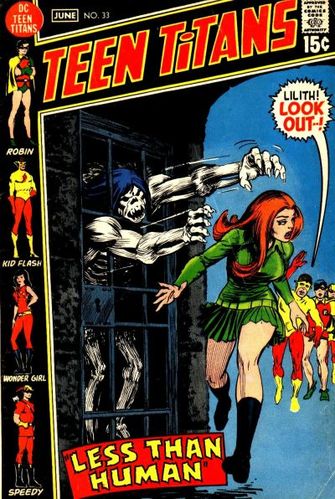




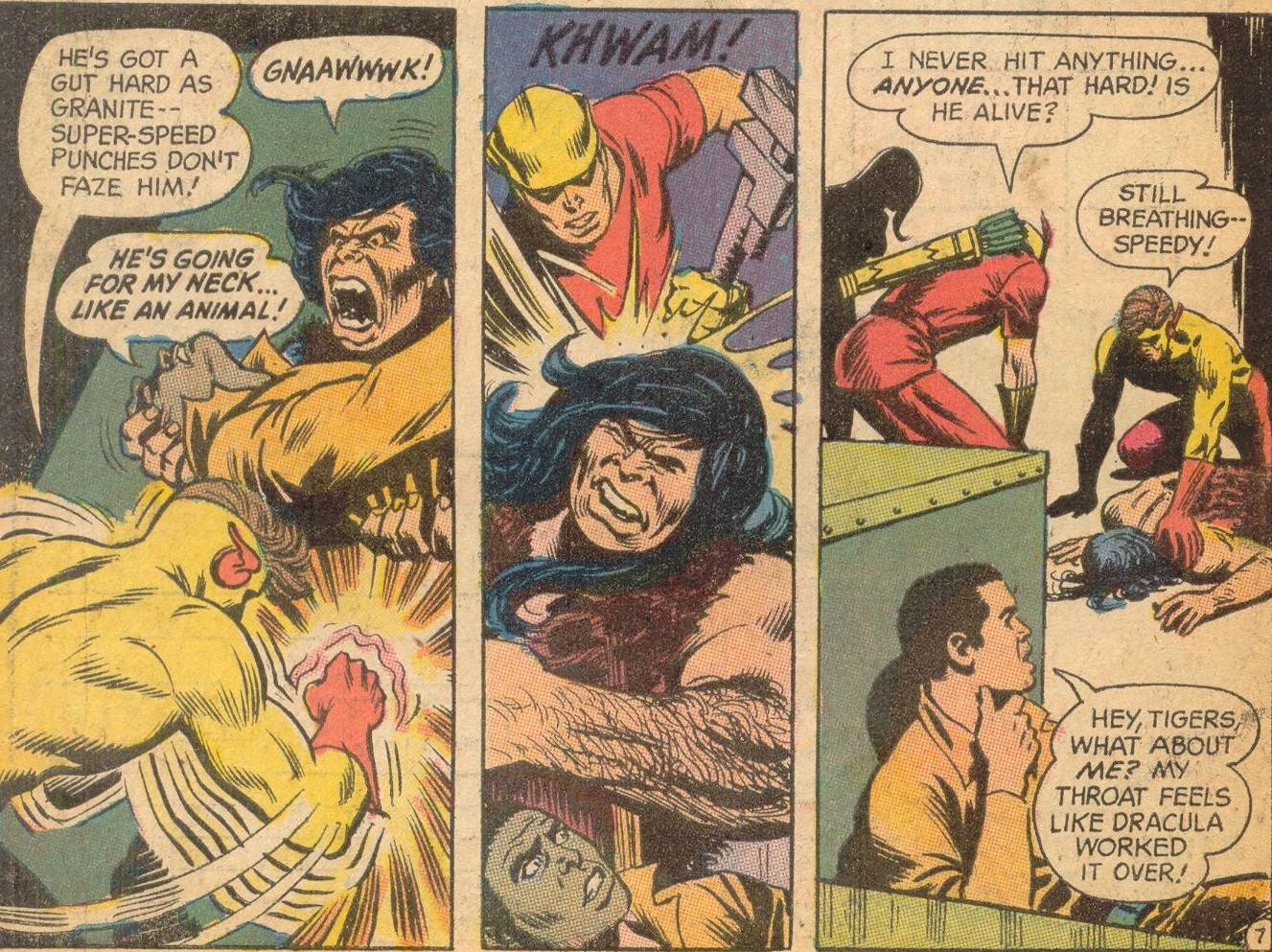





 This is followed quickly by being shot down herself in a more literal fashion as bullets riddle the van and the vaguely-powered vixen is hit. The Caveman goes crazy and tears into the attackers. The rest of the Titans arrive just in time to talk him down from killing his captives, but the Cro-Magnon chooses to do the right thing, sparing the would-be killer. The next day, Gnarrk appears in court and haltingly gives his testimony, bringing down the crime boss, and the comic ends with Lilith and her newfound friend walking off together, arm-in-arm.
This is followed quickly by being shot down herself in a more literal fashion as bullets riddle the van and the vaguely-powered vixen is hit. The Caveman goes crazy and tears into the attackers. The rest of the Titans arrive just in time to talk him down from killing his captives, but the Cro-Magnon chooses to do the right thing, sparing the would-be killer. The next day, Gnarrk appears in court and haltingly gives his testimony, bringing down the crime boss, and the comic ends with Lilith and her newfound friend walking off together, arm-in-arm.
















